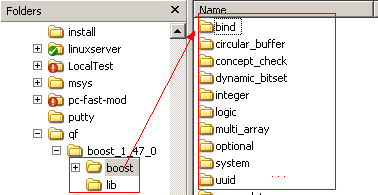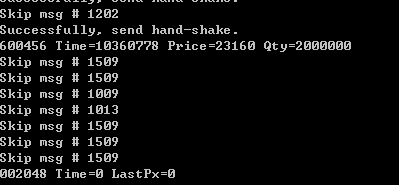编译链接level2行情转码机.
下载quickfast项目(windows平台):
http://quickfast.googlecode.com/files/quickfast_win_src_1_4.zip
下载第三方库:
1,下载activeperl
(google it)
2,下载mpc
http://www.ociweb.com/products/mpc
3,下载boost
(google it)
4,下载xerces
http://xerces.apache.org/xerces-c/
下载 行情转码库的配置脚本setup.bat(gif文件另存为zip,解压可以得到bat文件)
http://hi.csdn.net/attachment/201112/13/0_1323743665laAL.gif
setup.bat配置脚本设置三方库路径和编译器选项
@REM 1) Customize this file by setting variables to suit your environment @REM 2) Also you should customize QuickFAST.features to enable particular features on your system. @REM 3) Delete the following line when you finishing customizing this file. @REM [==DELETED==]echo See remarks in %0 for information about setting your build environment @REM 4) And, then run the `m.cmd' to generate *.sln & *.vcproj files @echo off REM ===================================================================================== REM EDIT THE FOLLOWING LINES OR SET THESE VALUES IN YOUR ENVIRONMENT BEFORE RUNNING SETUP if "a" == "a%MPC_ROOT%" set MPC_ROOT=H:\workspace\qf\MPC if "a" == "a%XERCES_ROOT%" set XERCES_ROOT=H:\workspace\qf\xerces-c-3.1.1-x86-windows-vc-8.0 if "a" == "a%XERCES_LIBNAME%" set XERCES_LIBNAME=xerces-c_3 if "a" == "a%BOOST_VERSION%" set BOOST_VERSION=boost_1_47_0 if "a" == "a%BOOST_ROOT%" set BOOST_ROOT=H:\workspace\qf\%BOOST_VERSION% REM END OF VALUES TO BE SET REM =====================================================================================
注意:boost默认编译出来的include和lib不在同一个目录下,需要move一下。

在vc的命令行下,运行这个setup.bat && m.bat就可以生成QuickFast.sln
用vs2008打开QuickFast.sln编译连接,生成的文件在Output目录的相应配置文件夹下。
得到库以后,如何使用呢?
这个解决方案提供了很多例子,最简单的是TutorialApplication和InterpretApplication这2个例子。
也可以用doxygen生成文档。
http://hi.csdn.net/attachment/201112/26/0_1324861393eteG.gif
一个简单的例子实现
笔者用Codecs::SynchronousDecoder(同步解码,官方例子使用的是异步解码器)实现了一个简单的解码封装,
通过tcp socket从上游数据源获取fast的码流并且解码,
FAST码流是剥掉了STEP协议头以后STEP协议BODY部分用FAST编码过的内容。
Fast_Steam = Fast(STEP_PACKET - STEP_HEAD) = Fast(STEP_BODY)
FastDecoder.h是导出库的头文件
#ifdef __cplusplus
extern "C"
{
#endif
enum MarketTag
{
ShenzhenMarket = 0,
ShanghaiMarket = 1,
};
FASTDECODER_API
int RunDecoderLoop(const char * pIp
, unsigned short nPort
, MarketTag nMarketTag
, const char * templateFileName
, const struct IDataExInterface * pNotify
);
#ifdef __cplusplus
};
#endif
解码以后的数据通过接口中的pNotify接口来通知客户端更新数据
TestFastDecoder.cpp文件
struct IDataExInterface
{
void (__stdcall * pfnFeedStatus)(ConnectionStatus connStatus);
// 上海的更新接口
void (__stdcall * pfnFeed_SHFAST30_UA3202)(const SHFAST30_UA3202_t * );
void (__stdcall * pfnFeed_SHFAST30_UA3201)(const SHFAST30_UA3201_t * );
void (__stdcall * pfnFeed_SHFAST30_UA3113)(const SHFAST30_UA3113_t * );
// 深圳的更新接口
void (__stdcall * pfnFeed_SZFAST_103)(const SZFAST_103_t *);
void (__stdcall * pfnFeed_SZFAST_202)(const SZFAST_202_t *);
void (__stdcall * pfnFeed_SZFAST_201)(const SZFAST_201_t *);
void (__stdcall * pfnFeed_SZFAST_104)(const SZFAST_104_t *);
};
客户端可以这样调用
void Level2Thread(void * arg)
{
MarketTag nMarketTag = static_cast<MarketTag>((int)arg);
IDataExInterface * pNotify = new IDataExInterface;
memset(pNotify, 0, sizeof(IDataExInterface));
pNotify->pfnFeedStatus = FeedStatus;
switch (nMarketTag)
{
case ShenzhenMarket:
{
SetThreadAffinityMask(GetCurrentThread(), 1);
pNotify->pfnFeed_SZFAST_103 = Feed_SZFAST_103;
pNotify->pfnFeed_SZFAST_104 = Feed_SZFAST_104;
pNotify->pfnFeed_SZFAST_201 = Feed_SZFAST_201;
pNotify->pfnFeed_SZFAST_202 = Feed_SZFAST_202;
RunDecoderLoop(
"127.0.0.1"
, 1111
, MarketTag(ShenzhenMarket)
, ".\\fasttemplates_2.00.xml"
, pNotify);
}
break;
case ShanghaiMarket:
{
SetThreadAffinityMask(GetCurrentThread(), 2);
pNotify->pfnFeed_SHFAST30_UA3113 = Feed_SHFAST30_UA3113;
pNotify->pfnFeed_SHFAST30_UA3201 = Feed_SHFAST30_UA3201;
pNotify->pfnFeed_SHFAST30_UA3202 = Feed_SHFAST30_UA3202;
RunDecoderLoop(
"127.0.0.1"
, 2222
, MarketTag(ShanghaiMarket)
, ".\\template.2.03.xml"
, pNotify);
}
break;
}
return ;
}
/**
*
* 简单的开启2个市场的解码线程开始解码
* 导出函数RunDecoderLoop是一个循环过程
* 所以放在2个独立的线程中
*
**/ int main(int argc, char* argv[])
{
_beginthread(Level2Thread, 0, (void *)ShanghaiMarket);
_beginthread(Level2Thread, 0, (void *)ShenzhenMarket);
//Level2Thread((void*)ShenzhenMarket);
//Level2Thread((void*)ShanghaiMarket);
printf("Press any key to quit decoder.\n");
getchar();
return 0;
}
更新一下客户端从配置文件TestFastDecoder.ini读取配置信息
[Shanghai] IpAddr=127.0.0.1 Port=8888 Template=template.2.03.xml [Shenzhen] IpAddr=127.0.0.1 Port=5555 Template=fasttemplates_2.00.xml
新的Level2Thread
void Level2Thread(void * arg)
{
char szProfile [MAX_PATH] = "";
char szAppName [MAX_PATH] = "";
char szIpAddr [MAX_PATH] = "";
char szTemplate [MAX_PATH] = "";
unsigned short wPort = 0;
MarketTag nMarketTag = static_cast<MarketTag>((int)arg);
IDataExInterface * pNotify = new IDataExInterface;
memset(pNotify, 0, sizeof(IDataExInterface));
pNotify->pfnFeedStatus = FeedStatus;
pNotify->pfnFeed_SZFAST_103 = Feed_SZFAST_103;
pNotify->pfnFeed_SZFAST_104 = Feed_SZFAST_104;
pNotify->pfnFeed_SZFAST_201 = Feed_SZFAST_201;
pNotify->pfnFeed_SZFAST_202 = Feed_SZFAST_202;
pNotify->pfnFeed_SHFAST30_UA3113 = Feed_SHFAST30_UA3113;
pNotify->pfnFeed_SHFAST30_UA3201 = Feed_SHFAST30_UA3201;
pNotify->pfnFeed_SHFAST30_UA3202 = Feed_SHFAST30_UA3202;
SetThreadAffinityMask(GetCurrentThread()
, (nMarketTag == ShenzhenMarket) ? 0 : 1);
GetModuleFileNameA(GetModuleHandleA(NULL), szProfile, _countof(szProfile)-sizeof(szProfile[0]));
strrchr(szProfile, '\\')[1] = 0;
strcat_s(szProfile, _countof(szProfile), "TestFastDecoder.ini");
strcpy_s(szAppName
, _countof(szAppName) - sizeof(szAppName[0])
, (nMarketTag == ShenzhenMarket) ? "Shenzhen" : "Shanghai");
GetPrivateProfileStringA(szAppName
, "IpAddr"
, NULL
, szIpAddr
, _countof(szIpAddr)-sizeof(szIpAddr[0])
, szProfile);
wPort = GetPrivateProfileIntA(szAppName
, "Port"
, 0
, szProfile);
GetPrivateProfileStringA(szAppName
, "Template"
, NULL
, szTemplate
, _countof(szTemplate)-sizeof(szTemplate[0])
, szProfile);
RunDecoderLoop(
szIpAddr
, wPort
, nMarketTag
, szTemplate
// , nMarketTag == ShenzhenMarket
// ? ".\\fasttemplates_2.00.xml"
// : ".\\template.2.03.xml"
, pNotify);
//std::cout<<szIpAddr<<wPort<<szTemplate<<nMarketTag<<std::endl;
return ;
}
用Codecs::SynchronousDecoder解码fast的几个重要步骤
1, 构造xml解析对象
/************************************************************************ * * 全局的xml解析类 * * 注意: 多线程同时构造parser会资源冲突 * * ************************************************************************/ static Codecs::XMLTemplateParser parser;
2, 解析xml模板生成fast模板
/////////////////////////////////////////////
// Parse the templates from the template file
// errors are reported by throwing exceptions
// which are caught below.
std::ifstream tmplFile(templateFileName, openMode);
Codecs::TemplateRegistryPtr registry;
try {
registry = parser.parse(tmplFile);
}catch (std::exception & e){
std::cerr << e.what() << std::endl;
return -1;
}
3, 创建一个decoder对象
//////////////////////////////////////
// Create a sync decoder and
// setup attributes.
Codecs::SynchronousDecoder * pDecoder
= new Codecs::SynchronousDecoder(registry);
pDecoder->setHeaderBytes(0);
pDecoder->setResetOnMessage(false);
pDecoder->setLimit(0);
4, 实现一个消息消费者,并且注册给解码器
//////////////////////////////////////
// Create an application object to use
// the incoming data. In this case to
// accept complete messages and interpret
// them to standard out.
CMessageConsumerImpl * pHandler
= new CMessageConsumerImpl(nMarketTag
, pNotify
, pDecoder);
//////////////////////////////////////
// and use the interpreter as the consumer
// of generic messages.
Codecs::GenericMessageBuilder builder(*pHandler);
5, 接收网络数据包(放置在pFastBody, 长度位nBodyLength),开始解码
pDataSource = new Codecs::DataSourceBuffer(pFastBody , pFastHeader->nBodyLength);
try{
pDecoder->reset();
pDecoder->decode(*pDataSource, builder);
} catch (std::exception & e)
{
std::cout<<e.what()<<std::endl;
}
delete pDataSource;
pDataSource = NULL;
6,实现消息消费者接口
/// @brief A message consumer that attempts to produce a human readable version /// of a message that has been decoded by QuickFAST. class CMessageConsumerImpl : public Codecs::MessageConsumer
重写消费消息函数
virtual bool consumeMessage(Messages::Message & message);
7,消费消息的过程就是消息的格式化过程
在消息的格式化过程中,主要是遍历Message的各个filed,如果field是
一般类型,直接转换成相应的值;如果是sequence和group,则需要将
field转换成sequence和group,遍历;另外,由于sequence里面的每一个
item也是一个Message结构,所以需要以Message的方式遍历结构的每一个成员;
foreach(item in seq)
foreach(member in item)
========================
8, 待续
fast手工解码,参考spec
========================
输出:

=================================================================
项目源文件下载(将下面的gif链接另存为zip,解压->重命名->解压,有加密,确实有需要的朋友请留言获取)
最新版本
version 2.0,修改了日志打印方式和配置文件加载quickfast-v2-[8n0].zip.png
http://hi.csdn.net/attachment/201112/27/0_132498087296Py.gif
历史版本
version 1.0,项目源文件Examples-8n0.zip
http://hi.csdn.net/attachment/201112/26/0_132486187064m4.gif